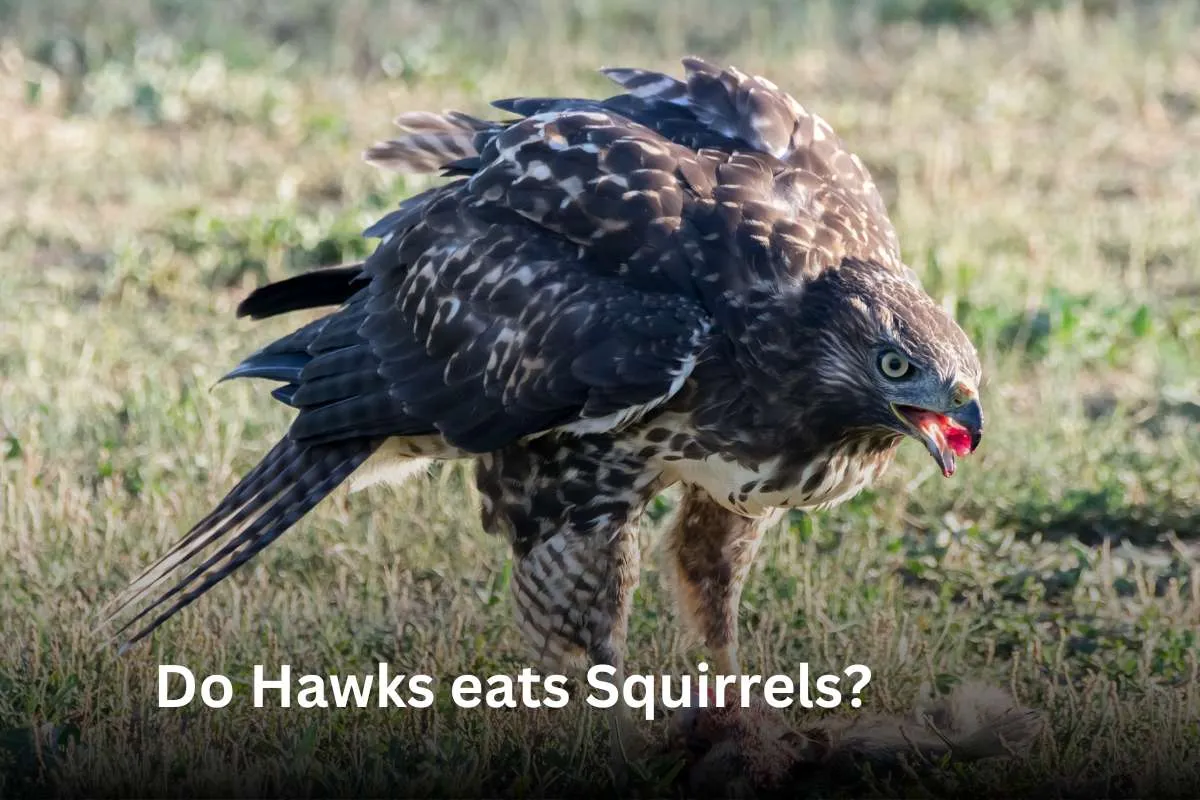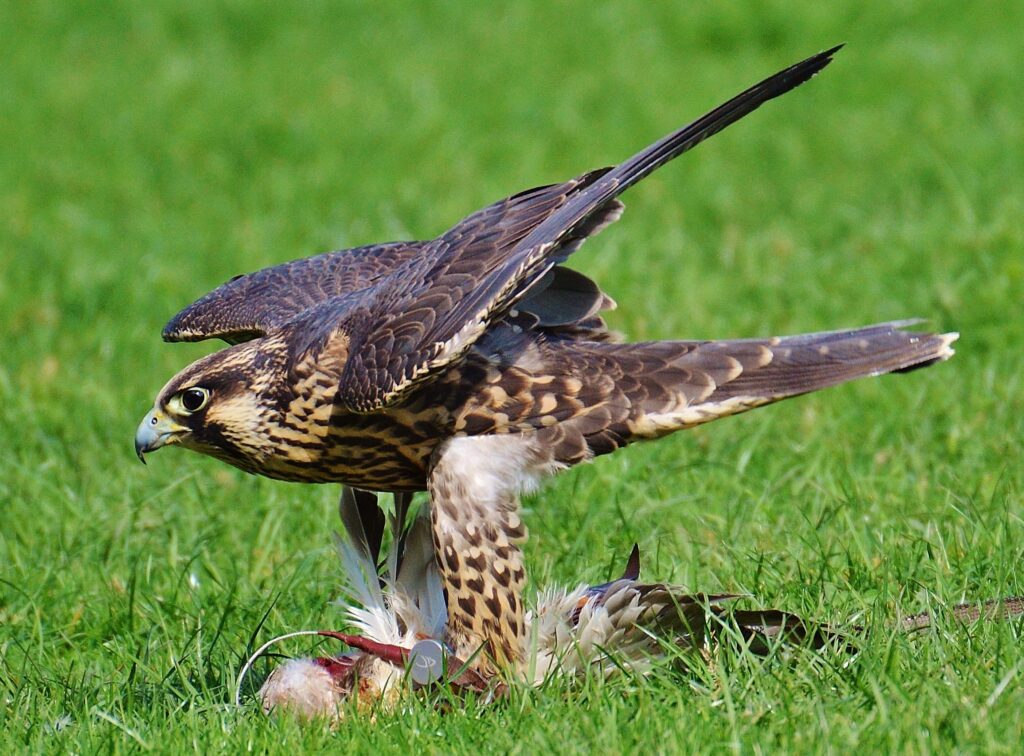Do Hawks eats Squirrels?

You’re out for a walk in the park when you notice a hawk circling above. It drops down abruptly toward a squirrel.
The squirrel makes it to a tree in time, and you sigh with relief. But it makes you wonder if hawks genuinely eat squirrels.
You’ve probably seen nature films of hawks swooping down and catching mice or bunnies. However, squirrels appear to be highly agile.
Can the Hawks actually capture and eat them? Yes, hawks eats squirrels.

Hawks and squirrels have long been natural enemies, but it varies by species.
In this post, we will look at the surprising relationships between certain hawks and squirrels. You may be surprised to learn which are predators and which are prey.
How Hawks Catch and Eat Squirrels?
As raptors, hawks are well-equipped to catch and consume squirrels. Their keen talons and beaks are perfect for seizing, killing, and tearing into the flesh of these furry rodents.
Hunting Squirrels
To catch a squirrel, a hawk will sit on a high branch and survey the surroundings for activity. When the hawk sees a squirrel, it swoops down at high speed, claws extended, ready to seize its victim.
The piercing claws pierce the squirrel’s body, and the hawk drags it away to a hidden location.
Killing and Eating
When the hawk catches the squirrel, it quickly kills it by puncturing its skull or snapping its neck with its beak.
It will then remove the squirrel’s fur with its beak and talons before tearing at the flesh. Hawks consume the whole squirrel, including its bones, organs, and teeth.
Hawks have powerful stomach acids and digestive enzymes that allow them to break down bones.
The hawk may take a portion of the squirrel immediately and save the rest for later. Caching, or hiding uneaten prey, permits the hawk to return for more food.
A hawk can eat a whole squirrel over a few days.
Adaptations for Hunting
Several characteristics make hawks effective squirrel hunters. Their excellent vision enables them to see squirrels from afar.
Strong claws are powerful grabbing tools, while sharp beaks are capable of killing and tearing flesh.
Hawks have lightweight, aerodynamic bodies and huge wingspans that allow for fast flight, chase, and capture.
Why Hawks Hunt Small Prey Like Squirrels?
Hawks are known for their hunting abilities, and their diet frequently includes a range of tiny animals, including squirrels.
Several reasons contribute to Hawks’ frequent targeting of squirrels for food.
Abundance and Availability
Squirrels are abundant in many of the areas where hawks live, offering them an easily accessible food supply.
Squirrels can be spotted climbing trees, feeding on the ground, and darting around in broad daylight in forests, urban parks, and suburban environments.
This abundance guarantees that hawks have a steady and continuous source of food.
Easy Targets
As much as hawks enjoy hunting squirrels, it all comes down to availability and convenience.
Squirrels are numerous, active during the day, and frequently let their guard down, making them easy prey.
Moreover, Squirrels, unlike larger prey, do not put up much of a fight and are easy to overwhelm.
Hunting squirrels is an easy way for hawks to acquire food without investing too much energy.
Suitable Size
While hawks are fearsome raptors, their ability to hunt larger animals is limited. Red-tailed hawks, one of North America’s most common hawks, usually weigh between two and four pounds.
Due to their size, squirrels are ideal hunting animals. Larger prey, such as rabbits, woodchucks, and grouse, might be more challenging and risky for hawks to catch.
Squirrels are in the sweet spot between being substantial enough for a meal and being too little to overpower.
Opportunistic Feeders
Hawks are opportunistic predators, which means they hunt whatever food is available and are easily captured at the time.
If squirrels are wandering around, hawks will gladly take advantage. If different prey, such as mice, snakes, or frogs, become more active or abundant, hawks may adjust their attention.
Many hawk species’ diets vary according to location, season, and the availability of various foods. While squirrels are on the menu, hawks will hunt any prey that requires the least amount of effort.
Understanding Hawks
Brief Description of Hawks and Their Characteristics
Hawks are a varied group of birds of prey recognized for their muscular bodies, excellent hunting abilities, and broad presence in a variety of habitats.
These raptors are members of the Accipitridae family and are distinguished by their large wings, robust bodies, and hooked beaks.
Hawks range in size from the little sparrowhawk to the enormous red-tailed hawk, and each species specializes in a unique environment, such as dense woods or open fields.

Their plumage is frequently a mix of browns, whites, and grays, which provides excellent camouflage in their native environment.
With nearly 200 species worldwide, hawks play an essential role in preserving ecological balance by reducing the number of tiny mammals, birds, and insects.
Sharp Claws and Beaks
Hawks’ sharp claws and beaks are among their most distinguishing features. They have explicitly evolved to hunt and devour prey.
Their claws are long, curved, and razor-sharp, allowing them to seize and immobilize prey with a tremendous grip.
These strong claws can slice through their victim’s flesh, preventing even the most agile or robust prey from escaping. Hawks utilize their claws to capture and kill a wide range of species, including rodents, birds, and small mammals.
Hawks have solid and hooked beaks to complement their claws, which are great for shredding flesh.
This beak structure enables hawks to efficiently break down their prey, making it easier for them to ingest and feed their young. Due to their physical characteristics, hawks are excellent hunters.
Exceptional Eyesight
Hawks have incredible eyesight, which helps them to see possible prey from long distances.
Their vision is among the most acute in the animal kingdom, with some species seeing up to eight times as clearly as humans.
This exceptional visual acuity is owing to a high density of photoreceptor cells in their retinas, particularly in the central fovea, which provides acute central vision.
Hawks have a second fovea, which improves their ability to track moving things. Their huge eyes are fitted with a bony ridge to protect them from harm and glare.
Hawks’ exceptional vision allows them to spot even the smallest changes in their environment, whether it’s a mouse scurrying through the grass or a bird soaring at a distance, making them incredibly effective predators.
The Diet of Hawks
Hawks are flexible and opportunistic hunters, with diets that vary significantly according to species, location, and prey availability.
Hawks are birds of prey that predominantly consume other animals, capturing and devouring them with their quick eyesight, sharp claws, and powerful beaks.
Aside from squirrels, Hawks have a few prey that include the following:
Small Mammals
Hawks are opportunistic predators, eating whatever tiny animals are available in their surroundings.
A hawk’s food includes squirrels, rabbits, mice, voles, and shrews. Some hawk species that hunt in more open regions may predominantly eat small burrowing creatures such as prairie dogs or ground squirrels.
Reptiles and Amphibians
Many hawks devour small animals and reptiles, such as lizards, snakes, and frogs. More prominent hawks can kill toxic snakes and feed them to their offspring.
Hawks that hunt near lakes, streams, and marshes frequently catch frogs, toads, and tiny turtles.
Birds
Many hawk species prey on smaller birds, particularly during the breeding period, when birds are most active and vulnerable.
Cooper’s hawks hunt on songbirds, but red-shouldered hawks eat a variety of species, including sparrows and ducks.
The hawk’s speed and agility allow it to swoop down and catch birds from the air or treetops.
Insects
You might be shocked to find that hawks, particularly smaller species, consume insects and other arthropods.
Hawk stomachs have been found to include grasshoppers, beetles, crickets, and spiders, which are then fed to nestlings.
| Note: Insects offer hawks a convenient supply of protein, particularly in the spring and summer. |
As you can see, hawks eat significantly more than only squirrels. These raptors are opportunistic predators, feeding on whatever food is available and abundant in their environment.
While squirrels are an essential element of a hawk’s diet in many locations, they are far from the primary source of food for these deadly birds of prey.
Conclusion
So, there you have it. The truth is that squirrels are one of many prey items that hawks eat, but they are not the hawks’ sole source of sustenance.
Hawks are opportunistic predators who will consume whatever little animal they can get their claws on. Squirrels are basically common prey that hawks may easily take, especially young and weak ones.
It is nature’s way of keeping the squirrel population under control. As unpleasant as it may appear, hawks eating squirrels is all part of the natural cycle of life.
When you see a hawk circling above or perched on a branch, check for its bushy tails. Chances are, the hawk is looking for its next squirrel supper!
FAQ
Do Hawks eat Squirrels?
Yes, hawks eat squirrels, which are a common food source for hawks, supplying needed nutrients as well as a large meal. Hawks use their good eyesight and sharp talons to hunt squirrels, which are plentiful and straightforward to spot in their natural environments.
Do Hawks hunt Squirrels all year round?
Hawks can hunt squirrels all year, but the frequency varies depending on the season and available prey. During the colder months, when other food sources are limited, hawks may rely more heavily on squirrels, making them an increasingly important part of their diet.






